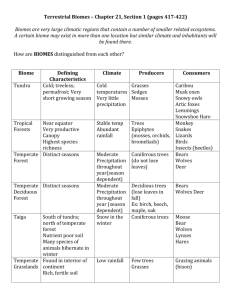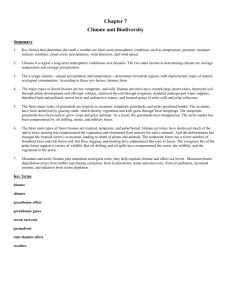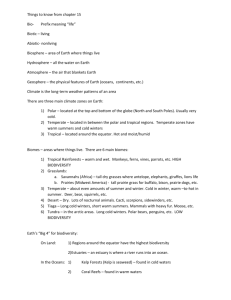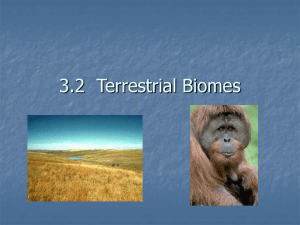Practice Test & Answer Key - Liberty Union High School District
advertisement
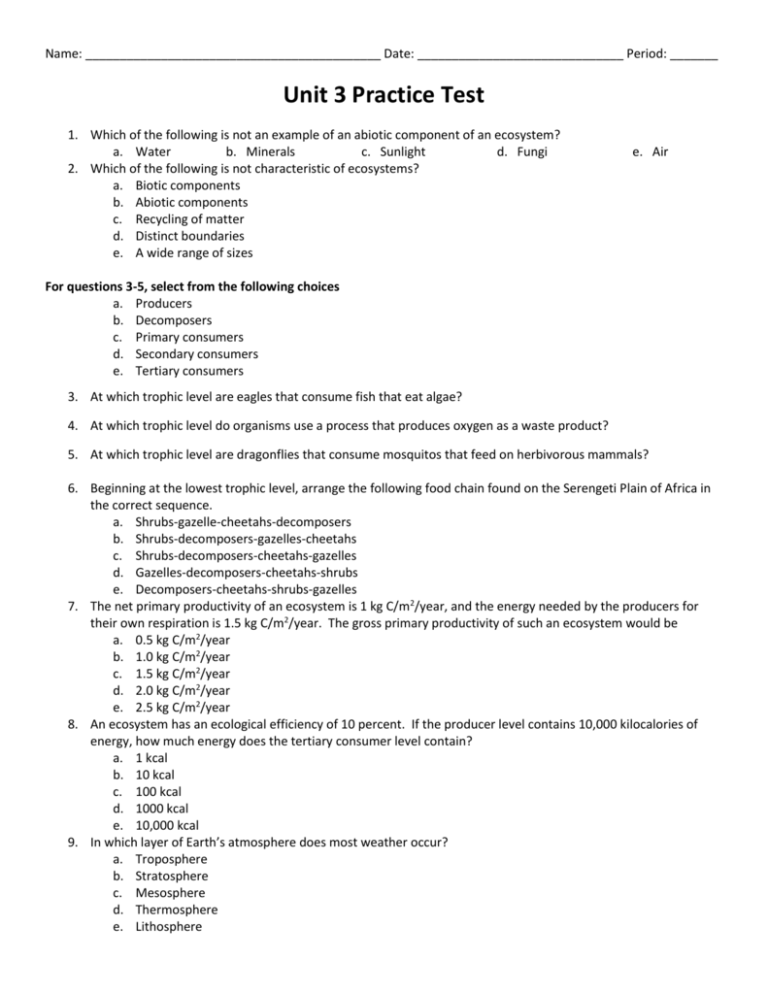
Name: ___________________________________________ Date: ______________________________ Period: _______ Unit 3 Practice Test 1. Which of the following is not an example of an abiotic component of an ecosystem? a. Water b. Minerals c. Sunlight d. Fungi 2. Which of the following is not characteristic of ecosystems? a. Biotic components b. Abiotic components c. Recycling of matter d. Distinct boundaries e. A wide range of sizes e. Air For questions 3-5, select from the following choices a. Producers b. Decomposers c. Primary consumers d. Secondary consumers e. Tertiary consumers 3. At which trophic level are eagles that consume fish that eat algae? 4. At which trophic level do organisms use a process that produces oxygen as a waste product? 5. At which trophic level are dragonflies that consume mosquitos that feed on herbivorous mammals? 6. Beginning at the lowest trophic level, arrange the following food chain found on the Serengeti Plain of Africa in the correct sequence. a. Shrubs-gazelle-cheetahs-decomposers b. Shrubs-decomposers-gazelles-cheetahs c. Shrubs-decomposers-cheetahs-gazelles d. Gazelles-decomposers-cheetahs-shrubs e. Decomposers-cheetahs-shrubs-gazelles 7. The net primary productivity of an ecosystem is 1 kg C/m2/year, and the energy needed by the producers for their own respiration is 1.5 kg C/m2/year. The gross primary productivity of such an ecosystem would be a. 0.5 kg C/m2/year b. 1.0 kg C/m2/year c. 1.5 kg C/m2/year d. 2.0 kg C/m2/year e. 2.5 kg C/m2/year 8. An ecosystem has an ecological efficiency of 10 percent. If the producer level contains 10,000 kilocalories of energy, how much energy does the tertiary consumer level contain? a. 1 kcal b. 10 kcal c. 100 kcal d. 1000 kcal e. 10,000 kcal 9. In which layer of Earth’s atmosphere does most weather occur? a. Troposphere b. Stratosphere c. Mesosphere d. Thermosphere e. Lithosphere 10. Which of the following best explains why polar regions are colder than tropical regions? a. Polar regions have lower albedo values b. Polar regions receive less solar energy per unit of surface area c. Tropical regions receive less direct sunlight throughout the year d. Sunlight travels through more atmosphere and loses more energy in tropical regions e. Tropical regions rotate at a faster speed than polar regions 11. Which of the following statements about patterns of temperature and precipitation is not correct? a. The air in a Hadley cell rises where sunlight strikes Earth most directly. b. The greatest amount of precipitation occurs at the intertropical convergence zone c. The air in a Hadley cell descends near 30⁰N and S, causing the formation of deserts. d. The air of a polar cell rises near 60⁰ latitude e. Along Earth’s surface, the air of a Hadley cell moves away from the equator. 12. Why do scientists use dominant plant growth forms to categorize terrestrial biomes? a. Plants with similar growth forms are always closely related genetically b. Different plant growth forms indicate climate differences, whereas different animal forms do not c. Plants from similar climates evolve different adaptations d. Similar plant growth forms are found in climates with similar temperatures and amounts of precipitation e. Similar plant growth forms exist in terrestrial and aquatic biomes 13. Which information is not found in climate diagrams? a. Average annual temperatures b. Seasonal changes in temperature c. Average annual humidity d. The months when plant growth is limited by precipitation e. The length of the growing season 14. Which of the following statements about temperate biomes is not correct? a. Temperate biomes have average annual temperatures above 20⁰C b. Temperate rainforests receive the most precipitation, whereas cold deserts receive the least precipitation c. Temperate rainforest can be found in the northwestern United States d. Temperate seasonal forests are characterized by trees that lose their leaves e. Temperate shrublands are adapted to frequent fires 15. Which of the following statements about tropical biomes is correct? a. Tropical seasonal forests are characterized by evergreen trees b. Tropical rainforest have the highest precipitation due to the proximity of the ITCZ c. Savannas are characterized by the densest forests d. Tropical rainforests have the slowest rates of decomposition due to high rainfall e. Subtropical deserts have the highest species diversity 16. Using the given pyramid of energy flow (to the right), calculate the amount of energy that moves through each trophic level. Start with the first trophic level – grass – at 100,000 kcals. How much energy moves to the second trophic level (primary consumer) rabbits? Use the chart below to fill in your answers. Between trophic Percentage of energy Energy in kcals that moves to levels efficiency the next trophic level? Grass to rabbits 12% energy efficiency Rabbits to foxes 14% energy efficiency Foxes to hawks 8% energy efficiency hawk fox rabbit grass - 100,000 kcals 17. How much paper do you use? The forested biomes of the world contain dozens of species of trees that are used for making paper products such as cardboard, newspaper, tissues, and paper for writing and printing. The average person in the US consumes about 300 kg (661 pounds) of paper products per year, and 30 percent of those products consist of paper for writing and printing. DON’T USE A CALCULATOR a. How much paper does the average person in the US use annually for writing and printing? b. Given that the US population was 308 million people in 2009, how many kilograms of total paper products are used annually by the US population? c. If the average tree produces 30 kg (66 pounds) of writing and printing paper, how many trees would be used annually for this paper if all of the paper came from trees? d. If 50 percent of all writing and printing paper could be made from 100 percent recycled paper, how many fewer trees would be needed for making paper? e. About 18 million students attend college in the US annually, and each of these students purchases new textbooks containing an average of 18 kg (40 pounds) of paper each year. If recycled paper is not used to make these textbooks, how many trees would be consumed annually to make textbooks? Questions 18-19 refer to the following regions of Earth’s atmosphere. a. Thermosphere b. Exosphere c. Troposhpere d. Mesosphere e. Stratosphere 18. The phenomenon causing global warming occurs primarily in this region of the atmosphere. ____ 19. The beneficial ozone layer is in this region of the atmosphere. _____ Questions 20-21 refer to the layers of Earth’s atmosphere in the temperature profile shown below. 20. Region largely responsible for the weather experienced at the Earth’s surface ______ 21. Region with the lowest atmospheric pressure _____ 22. Which of the following factors is fundamentally responsible for seasons on Earth? a. The varying distance of Earth from the Sun b. The tilt of Earth’s axis of rotation c. The latitudinal variation in temperature and precipitation d. The tidal pull of the Sun and Moon e. The anthropogenic greenhouse effect Answer Key: 1-d, 2-d, 3-d, 4-a, 5-e, 6-a, 7-e, 8-b,9-a, 10-b, 11-e, 12-d, 13-c, 14-a, 15-b 16- 12,000kcal 1680kcal 134kcal 17a-90kg or 198 pounds 17b-90kg/person * 308 million = 27720 million kg/27.7 billion kg 17c-27720 million kg/30kg per tree = 924 million trees 17d-924 million *0.5 = 462 million trees 17e-18 million students * 18kg/student ÷ 30kg per tree = 10.8 million kg 18-c, 19-e, 20-a, 21-3, 22-b
